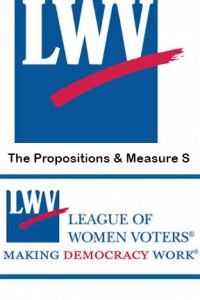League of Women Voters Forum on the Propositions & Measure S
LWV Forum on Ballot Measures
 On Tuesday morning, the League of Women Voters held an informational forum on propositions and measures which will be on the ballot in the upcoming election. Jane Person and Jerry Stavely headed the forum, providing detailed information on Propositions 1, 2, 45, 47, 46, 48, and Measure S. The information included the issue each proposition posed, a synopsis of each issue, who the opponents and supporters are for each and how much funding they have procured to date, and arguments for and against each issue.
On Tuesday morning, the League of Women Voters held an informational forum on propositions and measures which will be on the ballot in the upcoming election. Jane Person and Jerry Stavely headed the forum, providing detailed information on Propositions 1, 2, 45, 47, 46, 48, and Measure S. The information included the issue each proposition posed, a synopsis of each issue, who the opponents and supporters are for each and how much funding they have procured to date, and arguments for and against each issue.
Person and Stavely noted several websites to help voters navigate the details, pros and cons, of each measure. Ballotpedia.org is one they highlighted. Though they both did a heroic job of dissecting the convoluted language of several propositions, some points were still difficult to nail down.
Proposition 1, the Water Bond, would enact the Water Quality, Supply, and Infrastructure Improvement Act of 2014. Stavely provided some history on the bond, informing listeners that this measure was originally Proposition #43. He noted that between 1996 and 2006, other propositions for water related bonds had been passed, and that around 11 billion dollars has been put into water bonds. The current water bond would entail selling 7.12 billion dollars of new bonds for water projects to increase water supplies such as dams, public water system improvements, drinking water protection, water supply management and conveyance, wastewater treatment, drought relief, and protecting and restoring watersheds. The measure would also call for redirecting unused money from prior water bond acts, for same purposes. 5.7 billion dollars would have to be matched from non-state sources.
Stavely pointed out that none of the funding may be used for a canal or tunnel, as Governor Jerry Brown had proposed in his Twin Tunnel project, to transport water from Northern California down to Southern California.
Supporters argue that the Water Bond would be the most fiscally responsible plan, will help the economy and protect the environment.
Opponents argue that this bond contains “pork barrel” projects not in the state’s interest, that the public will have to pay for adverse effects of private interests, and that it does little to mitigate the drought situation facing us today.
The bottom-line: In order to service the debt on the Water Bond, the state of California would be paying 360 million dollars annually for the next 30-40 years.
This bond has the support of both major political parties and other groups including the California Farm Bureau, Audubon Society, and the Nature Conservancy. Those in opposition include various sports fisherman organizations, Environmental Water Caucus, Center for Biological Diversity and the Winnemem Wintu Tribe.



Most of the printed story is about Prop 1, but there’s more:
Wesley Chesbro is also opposed to Prop 1.
Recent history tells more than the decade between 1996-2006.
In 2009, the fifth bill was an $11.14 billion bond proposal, the Safe, Clean, and Reliable Drinking Water Supply Act of 2010. To get legislative support to pass this bond bill, the leadership included funding for a wide range of projects around the state.
This water bond was to be voted on in the general election in November 2010, but the Governor pulled it from the ballot with the concurrence of legislators, sensitive to criticisms of what has been referred to as “pork” in the bond and concerned that California’s voters would not support such a large bond during a statewide recession. With minor modifications, the water bond was rescheduled for the November 2012 ballot but pulled again by Governor Brown and legislators for the same reasons.
Faced with allowing the highly criticized $11.14 billion bond to go to voters in November 2014, and under mounting pressure caused by serious statewide drought conditions, Governor Brown and legislators came together after the regular deadline for placing measures on the ballot to negotiate the present $7.545 billion proposal.
Oct 15, 2014 Press Release VOTE NO ON PROP 1
Opponents of Prop. 1 include: (Signers of official arguments)
Assemblymember Wesley Chesbro, Chair, Natural Resources Committee
Conner Everts, Executive Director, Southern California Watershed Alliance
Barbara Barrigan-Parilla, Executive Director, Restore the Delta
Adam Scow, California Director, Food & Water Watch
Zeke Grader, Executive Director, Pacific Coast Federation of Fishermen’s Associations
Groups also Opposed to Prop 1:
AFSCME District Council 57
Ballona Institute
Butte Environmental Council
California Sportfishing Protection Alliance
California Striped Bass Association
California Water Impact Network
CREDO
Chico Conservation Voters
Coast Action Group
Center for Biological Diversity
Central Delta Water Agency
Concerned Citizens Coalition of Stockton
Environmental Protection Information Center (EPIC)
Environmental Water Caucus
Factory Farm Awareness Coalition
Friends Committee on Legislation of California
Friends of the Eel River
Friends of the River
Food and Water Watch
Foothill Conservancy
Pacific Coast Federation of Fishermen’s Associations
Potrero Hill Democratic Club
Pulga Rancheria Concow Maidu Indians
Restore the Delta
Sacramento River Preservation Trust
San Francisco Baykeeper
San Francisco Crab Boat Association
Save the American River Association
Small Boat Commercial Salmon Fishermen’s Association
Sherman Island Duck Hunters Association
Sonoma County Conservation Action
South Delta Water Agency
Southern California Watershed Alliance
Tar Sands Action
Wetlands Defense Fund
Wild Heritage Planners
Winnemem Wintu Tribe
Why Bay Area Voters Should Vote NO on Prop 1:
http://www.noonprop1.org/
PDF
http://www.noonprop1.org/wp-content/uploads/2014/09/Why-Bay-Area-Residents-Should-Vote-NO-on-Prop-1.pdf
Tomas DiFiore